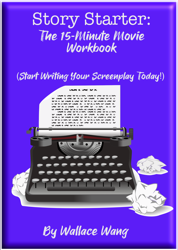When writing a screenplay, the last thing you should do is touch your screenwriting word processor. Yet that’s usually the first thing most people do, which results in creating a complete mess of a script. That’s because when you’re trying to write a scene in screenplay format, you’re trying to do multiple tasks at once:
- Tell your story
- Format your story as a screenplay
- Make up dialogue
- Create conflict
- Reveal character motives
As a general rule, if you can’t write a great scene, you’ll never write a great screenplay. So focus first on writing great scenes. When you can consistently write great scenes, then you can paste them together to create a great screenplay.
Rather than try to go from a rough idea to a polished screenplay in one massive leap, focus on the purpose of the scene and how you want it to end. Every scene must have a purpose or else there’s no reason for it to exist. Knowing how your scene ends means you have a purpose for the scene. The purpose of every scene is to move the story forward, usually by completely shattering expectations.
In “Legally Blonde”, there’s an early scene where the hero, Elle, is certain that her boyfriend, Warner, is taking her out to dinner to propose. Her expectation is that he will propose. Of course, if he proposes, that scene would be relatively dull so the best way to shatter expectations is to look for the complete opposite for maximum contrast.
Elle thinks her boyfriend will propose. It turns out, he dumps her instead. That’s such a dramatic reversal that it can’t help but grab our attention and make us want to know how Elle will respond, and that’s the purpose of that scene – keep the story going.
So before you even write your scene, identify how it ends. Then define how it begins and make sure the beginning and ending are as diametrically opposite as possible for greatest contrast and drama. In “Legally Blonde”, the scene begins with Elle thinking her boyfriend is going to propose. The scene ends when her boyfriend dumps her instead.
Watch this short film where a man is quietly enjoying his lunch when a stranger sits down at his table and ultimately turns his life completely around.
In the beginning of this short film, a man just thinks he’s going to have a quiet lunch. As the stranger continues to talk, the man starts to warm up when he finds they have so much in common. Where he thought he was going to have a quiet lunch, now his expectations are that he’s met a new friend.
And that’s when the twist happens, which occurs at the midpoint of the scene. In the “Legally Blonde” scene, the midpoint occurs when Elle’s boyfriend dumps her. So the basic structure of the scene looks like this:
- Elle thinks her boyfriend is going to propose
- Her boyfriend dumps her instead
- Elle is shocked
In the short film above, the structure works the same:
- The man thinks he’s going to have a quiet lunch by himself, but gradually warms up to a talkative stranger
- The stranger starts revealing disturbing details about the man’s past that he thought he had run away from
- The man realizes the stranger has been stalking him and is seeking revenge that will likely come soon
Making the beginning of a scene completely opposite from the ending of that same scene is what creates dramatic movement in a story. The greater the contrast, the greater the drama.
Far too many novices write scenes that mimic real life where characters talk about trivial matters and do nothing interesting. However, once you know how your scene begins and how it ends in a completely opposite note, you can write dialogue that reflects each character’s desire.
In the short film, the man at lunch wants to be left alone, then gradually warms up to the stranger until he finally realizes the stranger’s goal. Meanwhile, the stranger knows his goal right from the beginning and he teases the man although such teasing initially looks like nothing important.
Once you’ve outlined the beginning of your scene, the ending that’s in complete contrast to the beginning, and the midpoint where the scene changes, then you’ll be in a far stronger position to write your scene.
Even then, resist the urge to write it in screenplay format. Instead, jot down ideas in text format like writing a short story. It’s far easier to change a scene when it’s defined as text than after you’ve gone through all the trouble to format it as a screenplay.
So the lesson is clear. The less time you spend using your screenwriting word processor, the more time you can plan, outline, and organize your scenes with far greater freedom.
Sign up to take a FREE course about how to write scenes in a screenplay.

